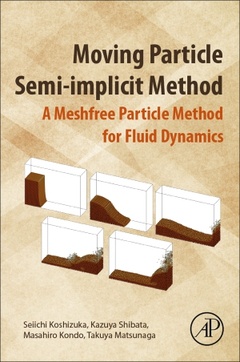Description
Moving Particle Semi-implicit Method
A Meshfree Particle Method for Fluid Dynamics
Authors: Koshizuka Seiichi, Shibata Kazuya, Kondo Masahiro, Matsunaga Takuya
Language: English
Subject for Moving Particle Semi-implicit Method:
Keywords
Arbitrary Lagrangian-Eulerian (ALE); Breakup behavior; Bubble calculation; Compressible-incompressible unified algorithm; Computational fluid dynamics; Continuum surface force; Discretization; Exercise of MPS simulation; FAQ; Fluid-rigid body interaction; Fluid-structure interaction; Free surface; Free-surface detection; Gas-liquid two-phase flow; Governing equations; Higher-order scheme; Incompressible flow; Industrial application; Lagrangian description; Lagrangian meshfree method; Liquid-solid phase change; Mechanical energy conservation; Meshless discretization; Microscale problem; Moving boundary problem; Moving particle semi-implicit (MPS) method; Multiresolution; Open boundary; Pairwise potential; Parallel computing; Particle boundary representation; Particle deficiency; Particle interaction model; Polygon boundary representation; Pressure Poisson equation; Pressure fluctuation; Pseudo-compressibility; Quaternion; Rigid body; Semi-implicit algorithm; Semi-implicit method; Solid wall; Source code of sample program; Structure analysis; Surface tension; Symplectic scheme; Theory of the MPS method; Turbulence model; Verification and validation (V&V); Weight function; Wettability
116.98 €
In Print (Delivery period: 14 days).
Add to cart306 p. · 15x22.8 cm · Paperback
Description
/li>Contents
/li>Readership
/li>Biography
/li>Comment
/li>
Moving Particle Semi-implicit Method: A Meshfree Particle Method for Fluid Dynamics begins by familiarizing the reader with basic theory that supports their journey through sections on advanced MPH methods. The unique insights that this method provides include fluid-structure interaction, non-Newtonian flow, and cavitation, making it relevant to a wide range of applications in the mechanical, structural, and nuclear industries, and in bioengineering. Co-authored by the originator of the MPS method, this book is the most authoritative guide available. It will be of great value to students, academics and researchers in industry.
1. Introduction2. Moving Particle Semi-implicit Method3. Extended Algorithms4. Boundary Conditions5. Surface Tension Models
Researchers, engineers and post-graduates with interest in computational fluid dynamics and meshfree particle methods.
Graduation from the Department of Systems Innovation of the University of Tokyo in 2002, Ph.D. from the University of Tokyo in 2007, Researcher of the National Maritime Research Institute in 2007, Research Associate of the University of Tokyo in 2009, Lecturer in 2013, and Associate Professor in 2017.
Graduation from the Department of Systems Innovation of the University of Tokyo in 2005, Ph.D. from the University of Tokyo in 2009, Researcher of the Central Research Institute of Electric Power Industry in 2010, Research Associate of the University of Tokyo in 2014, and Lecturer in 2016.
Graduation from the Department of Mechanical Engineering and Materials Science of the Yokohama National University in 2012, Ph.D. from the University of Tokyo in 2016, and Research Associate of the University of Tokyo in 2016.
- Presents the differences between MPH and SPH, helping readers choose between methods for different purposes
- Provides pieces of computer code that readers can use in their own simulations
- Includes the full, extended algorithms
- Explores the use of MPS in a range of industries and applications, including practical advice
These books may interest you

Recent Advances in Computational and Experimental Mechanics, Vol—ISelect Proceedings of ICRACEM 2020 316.49 €

Modern Fluid Dynamics 251.01 €


